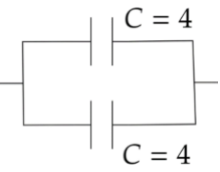
Net capacitance of three identical capacitors connected in parallel is $12$ microfarad. What will be the net capacitance when two of them are connected in (i) parallel (ii) series?
Answer
489.6k+ views
Hint:The given question has stated that there are three identical capacitors which means all have the same value of capacitance. We have to find the individual capacitance of capacitors. Then we will use the formula of parallel and series combination of capacitance to find the respective solution.
Complete step by step answer:
According to the question all the capacitors are identical. The total capacitance of the circuit when three are connected in parallel combination is $12$ microfarad.

Let the capacitance of each identical capacitor be $C$.
When the capacitors are arranged in parallel combination then we can write,
$\therefore 12 = C + C + C$
$ \Rightarrow 3C = 12$
Solving the equation we get,
$ \Rightarrow C = 4$ microfarad
(i)

Let us find the capacitance of the circuit when two capacitors are in parallel combination.Let the capacitance when two capacitors are connected in parallel be $C'$.We get,
$C' = 4 + 4 = 8$ microfarad
(ii)

Let us find the capacitance of the circuit when two capacitors are in series combination.Let the capacitance when two capacitors are connected in parallel be $C''$.We get,
$\dfrac{1}{{C''}} = \dfrac{1}{4} + \dfrac{1}{4}$
On solving the equation we get,
$ \therefore C'' = 2$ microfarad.
Therefore, when two capacitors are connected in parallel combination then the capacitance is $8$ microfarad and when in series combination gives $2$ microfarad.
Note: It must be noted that the formula of combination of circuit for capacitance is inverse to the combination of circuit for resistance. Capacitance of a circuit implies the energy stored in a capacitor. The parallel combination of a capacitor is just the algebraic sum of the values of each capacitance of a capacitor while the series combination is the sum of reciprocal of the values.
Complete step by step answer:
According to the question all the capacitors are identical. The total capacitance of the circuit when three are connected in parallel combination is $12$ microfarad.

Let the capacitance of each identical capacitor be $C$.
When the capacitors are arranged in parallel combination then we can write,
$\therefore 12 = C + C + C$
$ \Rightarrow 3C = 12$
Solving the equation we get,
$ \Rightarrow C = 4$ microfarad
(i)

Let us find the capacitance of the circuit when two capacitors are in parallel combination.Let the capacitance when two capacitors are connected in parallel be $C'$.We get,
$C' = 4 + 4 = 8$ microfarad
(ii)

Let us find the capacitance of the circuit when two capacitors are in series combination.Let the capacitance when two capacitors are connected in parallel be $C''$.We get,
$\dfrac{1}{{C''}} = \dfrac{1}{4} + \dfrac{1}{4}$
On solving the equation we get,
$ \therefore C'' = 2$ microfarad.
Therefore, when two capacitors are connected in parallel combination then the capacitance is $8$ microfarad and when in series combination gives $2$ microfarad.
Note: It must be noted that the formula of combination of circuit for capacitance is inverse to the combination of circuit for resistance. Capacitance of a circuit implies the energy stored in a capacitor. The parallel combination of a capacitor is just the algebraic sum of the values of each capacitance of a capacitor while the series combination is the sum of reciprocal of the values.
Recently Updated Pages
A man running at a speed 5 ms is viewed in the side class 12 physics CBSE

The number of solutions in x in 02pi for which sqrt class 12 maths CBSE

State and explain Hardy Weinbergs Principle class 12 biology CBSE

Write any two methods of preparation of phenol Give class 12 chemistry CBSE

Which of the following statements is wrong a Amnion class 12 biology CBSE

Differentiate between action potential and resting class 12 biology CBSE

Trending doubts
What are the major means of transport Explain each class 12 social science CBSE

Which are the Top 10 Largest Countries of the World?

Draw a labelled sketch of the human eye class 12 physics CBSE

Explain sex determination in humans with line diag class 12 biology CBSE

Explain sex determination in humans with the help of class 12 biology CBSE

Differentiate between homogeneous and heterogeneous class 12 chemistry CBSE




